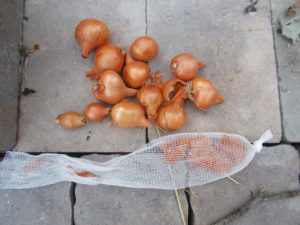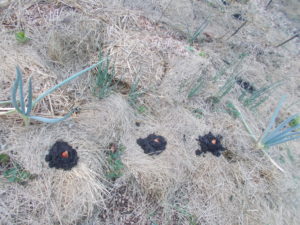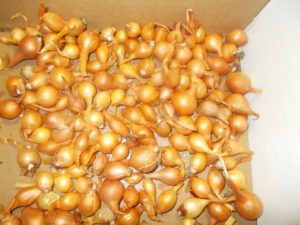Yellow Potato Onion (Allium cepa var. aggregatum) is a perennial onion.
The bulbs can be planted in fall from early October to early November. Plant 4in apart and leave the tip of the bulbs off the ground. Around the first frost, the young plants can be mulched to protect the underground parts.
During winter they would die back to the ground and sprout in spring. Each bulb planted would yield a cluster of 6 bulbs in average. They can be harvested around late June or early July when the tops turn brown and fall on the ground.
Harvest and lay in a shady area to dry. I store mine in a box in the garage and dry outside in the shade for 1 month. This allows them to cure and store longer. At the end of fall, I trim the stalks and store in my basement.
The bulbs can be small like shallot and sometimes smaller. They last longer in storage than shallot. I use them in fresh eating and sometimes in cooking. But I generally cook with Egyptian onion leaves.
Bulbs left in the ground in summer would go dormant and sprout in fall. But heavy rain in late summer could cause most of the bulbs in soggy area to rot.
Two years ago, I planted them and left them in the ground to test how perennial they are. A lot of them rotted. But many sprouted in fall. I also remarked that fall planting bulbs tend to yield big bulbs compared to spring planting. This year I ordered 11 Lbs and planted in spring. They grew well but yield smaller bulbs than the ones I planted in fall. I replanted them this fall. I forgot some bulbs in the ground in summer as I harvested them late and they died back and hard to find in the wood chips. They sprouted in late fall.
It is a learning process if you are used to big onion from the grocery store and would like to switch to perennial onion. If you grow your own food you have to find a way to use them more sustainably. When I used to buy onion at the grocery store, I used to use a lot of it as I buy it on sale. Now that I growing my own, I am trying to use it more in a sustainable way. I have limited space to grow food. Therefore, I use yellow potato onion in fresh eating and I only need 1-2 bulbs. If you grow your own food you would find a way to use it and limit waste. When cooking, we only need to sauté few diced onions in oil to impart the flavor to the whole food. We don’t need 2-3 big onions for that like the way I used to. I have not purchased onion from the grocery store at all this year and last year. In case you are wondering, you don’t need a lot of space to plant enough yellow potato onion for your needs. One bulb can be divided in 3-12 bulbs. You keep one or more for planting and the rest for eating.
Yellow potato onion is easier to plant than annual onion. To produce big onions you need to start annual onions indoor and plant outside early in spring. You don’t need to start seeds indoor for yellow potato onions like annual onions. You just plant them in fall. You can also plant bulbs for annual onions like I did this year. They yield small onions compare to the grocery store onion.
Regular onions are biennial but grown as annual as the produce seeds the second year. 1 seed or 1 bulb produces 1 onion relatively big while yellow potato onions multiply. You buy bulbs or seeds for regular onion every year.
You only buy yellow potato onions once and keep some bulbs during harvest for planting in fall. It is a perennial and would survive winter. I live in zone 5 and yellow potato onion overwinter well here. I mulch in fall with fall leaves. I don’t have to pay to get rid of the leaves. They go straight in my garden untraded.




